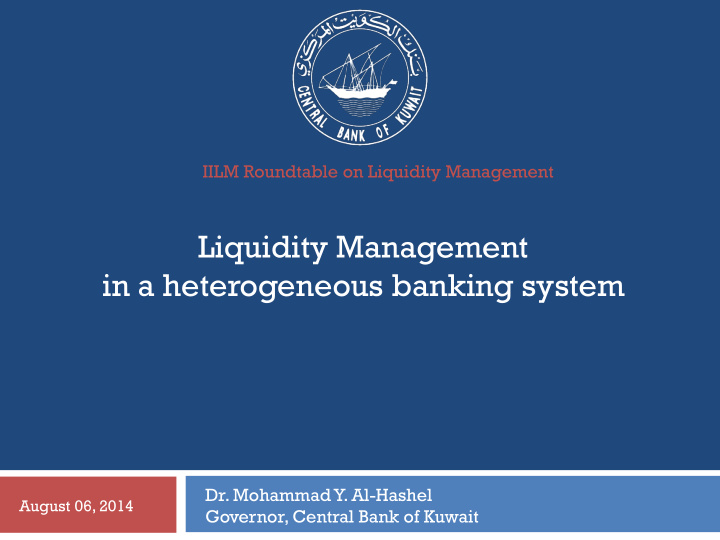



IILM Roundtable on Liquidity Management Liquidity Management in a heterogeneous banking system Dr. Mohammad Y. Al-Hashel August 06, 2014 Governor, Central Bank of Kuwait
Outline 2 Key mandate(s) of the central banks: monetary stability and financial stability Defining Liquidity Management ‘Heterogeneous’ Banking System ? Interaction between Conventional & Islamic banks Liquidity Management: challenges for Islamic banks Central Banks’ monetary operations Recent Liquidity regulations & Islamic banks Conclusion
Key mandate(s) of central banks 3 Ensuring monetary stability has been the raison d’etre of central banks Yet monetary stability was not enough to avert financial meltdown The growing recognition of financial stability as an equally important objective Limitations of monetary policy in addressing financial instability The use of ‘Macro Prudential Policy’ The topic of liquidity management: two key strands Day-to-day liquidity management & the use of monetary operations Liquidity regulations to ensure financial stability
Defining Liquidity Management 4 From the CB’s perspective: Acting as the transmission mechanism for both monetary operations and supervisory control Liquidity management has both micro & macro prudential implications CB’s liquidity management operations duly consider both economic and financial cycles
Heterogeneous Banking System 5 A ‘heterogeneous’ banking system? Both Islamic and conventional banks share a common base as financial intermediaries — homogeneity ‘Dual’ banking system better represents existing structure Admittedly, conventional banks had much longer time to develop CBs have a developmental role in helping Islamic banks grow and come to par with conventional counterparts
Interaction between Conventional & Islamic Banks 6 CBs need to encourage this interaction Addressing the reluctance to deal with each other CBs also need to avoid build up of surplus liquidity in one sector and shortage in the other Cooperation between conventional and Islamic Banks should ideally minimize intervention by the CB Efforts of the multilateral institutions would help improve mutual interaction between Islamic & conventional banks
Liquidity Management; Challenges for Islamic banks 7 Conventional banks can acquire instruments developed for Islamic banks However, opposite is not necessarily true Insufficient number of suitable industry benchmarks for pricing Conventional banks have the whole range in a variety of currencies Hardly any instrument compatible to interbank deposits The challenge of short term liquidity management Scarcity of Shariah-compliant securities to meet liquidity needs Resulting in ‘Buy and Hold strategy’….further limiting trading Absence of suitable Shariah- compliant “Lender of Last Resort’ and ‘Deposit Insurance Mechanism’ Requiring Islamic Banks to hold more cash/liquid assets As a consequence: Islamic banks’ high reliance on cash
CB’s Monetary Operations 8 Conduct of monetary operations in a dual banking system CBs must forecast liquidity needs ahead of time Yet liquidity forecasting is, at best, an imprecise science Establishing routine contacts with all market participants is critical To obtain useful information, and To better understand market expectations At CBK, we hold regular meetings with treasurers of all banks Departmental responsibilities are same irrespective of the type of bank Returns paid/received during monetary operations should be similar for both type of banks For conventional monetary instruments, yield is pre-determined Yet returns may not be quantifiable in case of transactions under Musharka/Mudarba setup CBs need to reduce the potential for yield anomalies between the two sectors
CB’s Monetary Instruments 9 Target interest rates & use of unconventional tools Need for acceptance across jurisdictions in case of similar tools for Islamic finance Insufficient pool of Islamic government securities Making liquidity management harder for CBs Legal impediments in using state assets to issue Shariah-compliant instruments Differences in the processes supporting the use of monetary instruments Need for Shariah committee’s approval of individual monetary transactions
Recent liquidity regulations & Islamic banks 10 Basel III Liquidity Regulations: Liquidity Coverage Ratio (LCR) Net Stable Funding Ratio (NSFR) Insufficient Shariah-compliant High Quality Liquid Assets (HQLA) Most of the available sukuk lack key characteristics of HQLAs Lack of deep & active secondary markets for Shariah-compliant HQLA Most sukuk are held to maturity, reducing the potential for active trading Demand for sukuk from conventional banks for portfolio diversification
Conclusion 11 Though the objectives of CB’s monetary operations are same, dual banking system poses its own challenges Avoiding the potential for regulatory arbitrage Given the existing constraints, Islamic banks face a challenge in both Day to day liquidity management Compliance with regulatory liquidity requirements The role of IILM is commendable in providing high quality short term sukuk Yet further progress is needed In developing appropriate liquidity management tools In designing suitable liquidity regulations in line with the Islamic banking model
Thank You ! 12
Recommend
More recommend